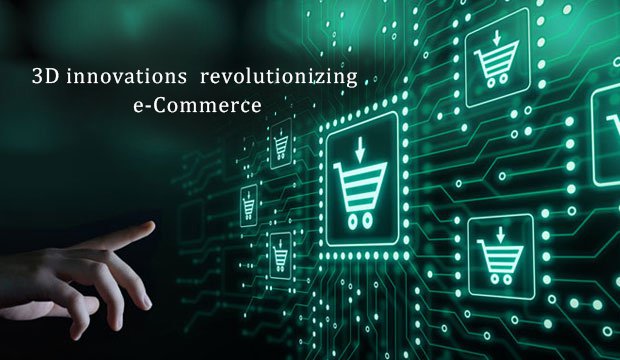
While the e-commerce landscape is regularly introduced to new technologies that drive shopping experiences, 3D is the latest, most impactful tech that is transforming online shopping experiences, particularly for high-value commodities like furniture and decor items.
Customers are loving the feel of looking at the products they desire in 3D on e-commerce stores.
Buyers need not worry about how a particular product will look in real life while shopping online. With 3D product renders, prospects can assess products as they would in a brick-and-mortar store and determine their exact color, texture and other important details. They can see real-time 3D product demonstrations to even figure out how certain products function.
Here are some of the most prominent 3D capabilities being widely used in the e-commerce sphere-
-CGI
-3D viewer
-3D animation
-AR
All of these capabilities require 3D renders of a product to display it in the most appealing way possible.
3D Modeling:
3D modeling is the process of transforming two-dimensional images into three-dimensional visuals using advanced software like 3Ds Max, Autodesk and Maya.
Researchandmarkets.com conducted a study which concluded that the 3D modeling industry value is going to progress at a CAGR of 21.75% and will be valued at USD 17.292 billion by 2023, staggeringly progressing from USD 5.310 billion in 2017. Many e-commerce companies complain of their reputation taking a hit due to discrepancies between their product demonstrations online and the actual product customers receive. This is where 3D technology can come in handy by offering accurate product representations and eliminating any discrepancies.
3D Rendering:
3D rendering has induced efficiency in eCommerce production and supply chains. This has proven to be especially beneficial for big-ticket products like furniture. Ecommerce companies can save valuable time and money by not having to manufacture product prototypes thanks to life-like 3D product renders. E-commerce players can offer highly detailed 3D product visuals right on their app or website, enhancing customer experiences.
3D rendering produces unmistakably real product visuals that can’t be differentiated from a high-quality product photograph. No need to invest hefty amounts in arranging for professional product photography when 3D rendering can do the job much more efficiently. According to Grand View Research Inc, the 3D rendering market is slated to grow at a CAGR of 22.5% between 2018 and 2025 – indeed a high-potential market that can upgrade online shopping experiences.
- Computer Generated Imagery (CGI):
Computer-generated imagery is using advanced computer graphic capabilities to turn a simple-looking 2D image into a highly detailed, life-like visual. Once a basic graphical representation of a product is ready, expert 3D artists can leverage their CGI skills to augment minute details and make them seem as real as possible. Enhancements are made in the texture, color, background and other areas of the image to make the product representation highly appealing yet accurately detailed. CGI can ideally substitute physical product photography for almost one-third of its cost. While physical photography demands the arranging of background accessories along with the physical prototype of the product, a CGI image can be created with nothing but a basic CAD drawing or a simple graphic of the product. To put things into perspective, IKEA, the biggest furniture retailer, has 75% of its entire product catalog as CGI images.
- 3D Animation:
3D animation brings static images to life by infusing motion and creating an illusion of movement. High-quality, engaging 3D product animations can be created using 3D models and don’t require real product photographs. Like 3D modeling and rendering, the 3D animation market is also expected to grow at a rapid pace in the coming times and become more and more prevalent in e-commerce stores.
As is obvious, video content is more engaging than visual and textual content. Today’s consumers have a very short attention span. They don’t want to read long, tedious articles describing your products. Video content accounts for 80% of all internet traffic and is a surefire way to keep prospects hooked on your sales channels. Instead of using conventional videos that can cost you big bucks, you can turn to 3D product animations that are much more engaging yet cost-efficient.
- 3D Viewer:
The 3D viewer technology enables online shoppers to virtually experience and look at products from every angle just like they would in a physical store. They can zoom in and get a life-like view of the design of the product and get as close to touching it and feeling its texture as possible in a virtual environment. Concerned about your virtual product representations failing to match in-store experiences? 3D viewer technology is the right choice for you.
- Augmented Reality (AR):
Imagine being able to place a virtual product image in a real environment and see how it looks in your surroundings. Sounds amazing and convenient right? This is exactly what AR technology makes possible. Customers can see before buying how a product will look in their environment and accordingly make a decision. Customers love using AR and more than 60% of them have indicated they want to shop using AR capabilities.
Customers don’t need to do guesswork regarding how a home accessory like a sofa will look in their room by taking into account its measurements. They can directly conjure up the entire sofa in their room by just using their phone’s camera and see whether it matches the ambiance and decor. AR opens up numerous marketing doors for businesses looking to reach prospects in a very innovative and engaging way.
3D is truly augmenting the e-commerce industry’s growth and making it more futuristic and customer-centric. The numerous purposes that a single 3D model can fulfill open up a world of exciting marketing opportunities for online stores. Businesses love it as it’s cost-efficient and drives positive customer actions and customers love it due to its functionality and innovativeness. And hence, 3D product modeling is truly a win-win situation for all stakeholders.